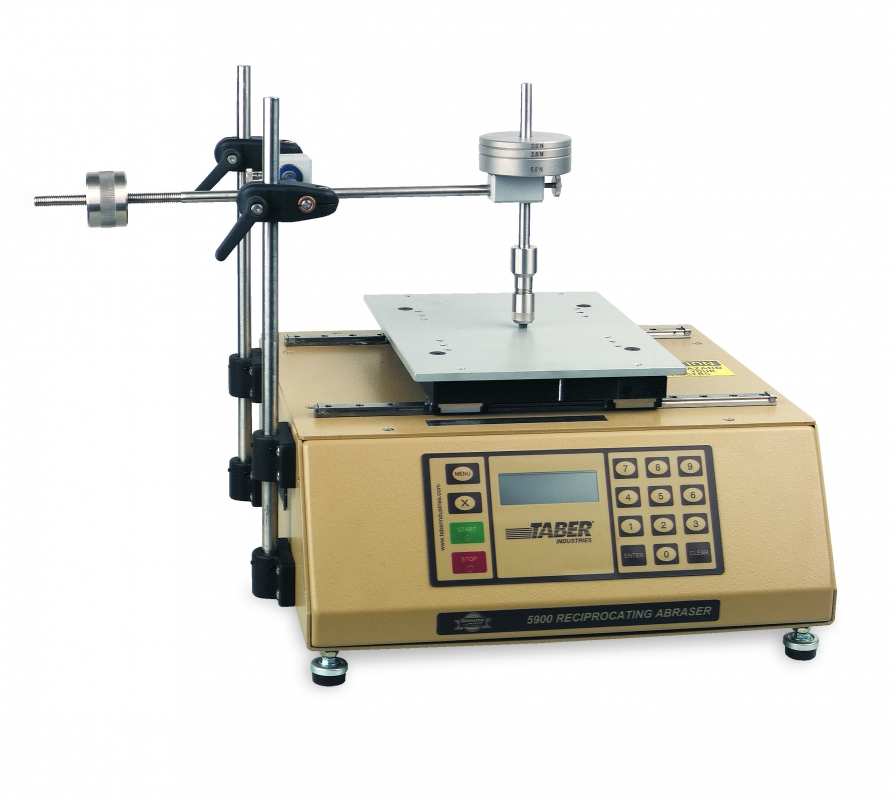Reciprocating Abraser (Abrader) 

The TABER® Reciprocating Abraser (Abrader) - Model 5900 is a test apparatus similar to the instrument described in test method ISO 1518. Ideal for flat surfaces, this tester can be configured with optional attachments to evaluate the relative resistance or susceptibility of a material surface to physical damage such as wear and abrasion, rub, scratch, mar, gouge, scrape, plus others.
Click here for information on scratch testing with the Reciprocating Abraser.
Description
The Taber Reciprocating Abraser includes a counterbalanced arm which pivots on an adjustable height gantry system. The counterweight allows the user to balance the test arm, ensuring precise test load set-up regardless of the weight of the attachment. Incorporated at the end of the arm is a tool holder to which optional attachments and weights may be secured. A sliding specimen platform moves in a horizontal, reciprocating motion under the stationary tool holder.
Test parameters such as stroke length (6 - 155mm), speed (3 - 75 cycles per minute) and load (1N - 24N maximum, with included weights of 1N, 2N, 2.5N, 5N, 10N & 24N) are adjustable so optimal settings for each material can be established.
To expand test loads, optional auxiliary weights are sold individually and available as 50g, 100g, 150g, 200g, 500g, 1000g, 2000g, 2400g and 5000g. In addition, an optional weight support may be affixed to the top of the tool holder. This permits using auxiliary weight discs originally intended for Taber's Linear Abraser 5750 (10g, 20g, 50g, 75g, 100g, 150g or 250g).

The Wearaser® collet assembly comes standard with each Taber Reciprocating Abraser, along with CS-10 and H-18 Wearaser abradants. The size and shape of a pencil eraser, the Wearaser is made using the same high quality Taber abrasive media found in our Genuine Taber abrading wheels. This permits the use of equivalent abrasive materials with the Reciprocating Abraser as well as Taber's Linear Abraser and the Taber Rotary Platform Abraser.
The standard specimen table provided with the Reciprocating Abraser is 216mm x 278mm (8.5" x 11") with drilled tapped holes to accommodate specimen clamps or optional specimen fixing plates. To evaluate most flat specimens, specimen clamps or the optional Wide Slot Fixing Plate may be suitable. For flexible materials such as textile products, the optional Specimen Fixing Plate Kit might be used. Products with a slight contour can also be secured in place using the specimen clamps provided or a custom fixture.
The Reciprocating Abraser can accommodate two additional test arm kits (sold separately), permitting up to three tests to be performed simultaneously.
Wear / Abrasion Attachments
For information on Wear / Abrasion Attachments for the Reciprocating Abraser, click here.
Evaluation
Due to the wide variety of test attachments that can be used with the TABER Reciprocating Abraser (Abrader), there is no universal method to interpret results. The two most common methods include:
Cycles to a Specific End-Point - The number of cycles required to reach a predetermined end point, or the appearance or condition of the specimen after a fixed number of cycles. The evaluation criteria may include: loss in coating, change in gloss, color loss, or other changes in appearance. In these cases, the abraded sample is usually compared to a known standard of the material tested. When visually inspecting changes in specimen appearance, evaluations should be made using an agreed upon rating system such as a visual grading scale (e.g. five-step) or pass/fail criteria.
Weight (Mass) Loss - This technique measures how much material has been removed by abrasion, and is usually reported in milligrams.
L = A - B
where L = weight loss
A = weight (mass) of specimen before abrasion
B = weight (mass) of specimen after abrasion
Test Methods
The following links provide a listing of test methods the Taber Reciprocating Abraser (Abrader) satisfies. Please note, additional accessories may be required.

